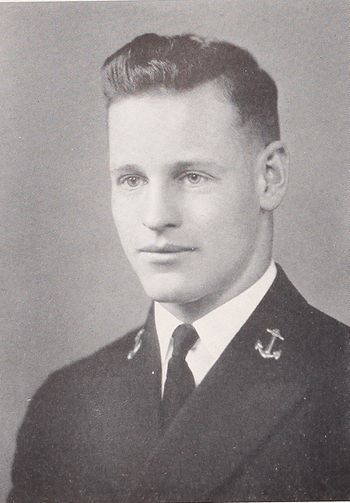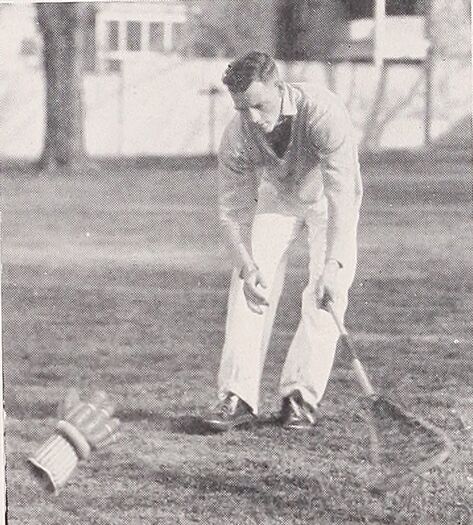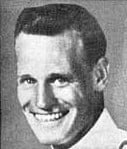DONALD F. BANKER, LCDR, USN
Donald Banker '40
Lucky Bag
From the 1940 Lucky Bag:
DONALD FRANCIS BANKER
Duluth, Minnesota
Don
When some one finds that his bed has been "grape-nutted," Don is often the rightfully suspected villain. But in spite of his fondness for practical jokes, Don is well liked by all who know him. His big, pleasant grin and ready wit carry him gracefully through almost any situation. But Don does have his more serious moments. Just for amusement, he likes to play around with mathematical "stumpers." Often, his spare time is devoted to reading books on philosophy, economics, or other involved subjects. Come what may in the free-for-all of life, Don is going to end up somewhere near the top of the heap.
Swimming 4, 3, 2, 1; Radio Club 4, 3, 2, 1; Company Representative 3; Hop Committee 1; Trident 1; N.A.C.A. Council 1; Boat Club 2, 1; Star 4.

DONALD FRANCIS BANKER
Duluth, Minnesota
Don
When some one finds that his bed has been "grape-nutted," Don is often the rightfully suspected villain. But in spite of his fondness for practical jokes, Don is well liked by all who know him. His big, pleasant grin and ready wit carry him gracefully through almost any situation. But Don does have his more serious moments. Just for amusement, he likes to play around with mathematical "stumpers." Often, his spare time is devoted to reading books on philosophy, economics, or other involved subjects. Come what may in the free-for-all of life, Don is going to end up somewhere near the top of the heap.
Swimming 4, 3, 2, 1; Radio Club 4, 3, 2, 1; Company Representative 3; Hop Committee 1; Trident 1; N.A.C.A. Council 1; Boat Club 2, 1; Star 4.
Loss
Don was lost on November 5, 1944 in the Phillippines. The Wikipedia entry on VA-194 has some more details.
Obituary
From History of Class of 1940:
After graduation, Don joined IDAHO. Two years later, on his way to flight training, he married Betty Bennett in Annapolis. It was December, 1943, when he joined VB 19, a divebomber squadron embarked in LEXINGTON.
On September 21, 1944, in the face of strong AA fire, Don sank a Japanese ship. For this, Admiral Mitscher awarded him the Distinguished Flying Cross. Exactly one month later, his son, now Donald Banker Heimark, was born.
On 24 October, he took command of VB 19 after the commanding officer had been lost to enemy action. The very next day he led his squadron in an attack against the Japanese Fleet. He personally scored a hit on an enemy battleship in the face of continuous, intense anti-aircraft fire. For this he was awarded a Silver Star.
In a second strike this same day, Don dove boldly through intense AA fire and scored a direct hit on a large Japanese carrier that led to its loss. For this act of skill and bravery, he received his first Navy Cross.
On November 5, the last day of his short life, Don led his flight of aircraft in offensive action against Japanese naval forces in Manila Harbor. Besides directing the efforts of his accompanying squadronmates to gain maximum striking power, Don dove through withering AA fire to a perilously low altitude before releasing his bombs for a direct hit that destroyed an enemy heavy cruiser. As Don pulled out of his dive, his plane was shot down and he was lost. For his superb airmanship, indomitable fighting spirit and extreme courage in the face of tremendous odds, Don was awarded a second Navy Cross and a Purple Heart.
In a brief seven-week period, Donald Banker became one of the most highly decorated members of '40.
Today, through his son Donald Banker, and his grandchildren, Emory Banker and Skyler Banker, our classmate Don lives on. Jake Heimark
His wife was listed as next of kin.
Donald is remembered at the Manila American Cemetery and Memorial.
Photographs
Remembrances
From "The Voices of Bombing Nineteen":
The day of 24 October began innocently enough with a number of searches being scheduled, all of which were to the west and beyond the inner shore of Luzon. As Don Banker's number two wingman, off I went with him, Wicklander, and Evatt on one of those searches with our VF escorts. Our sector was relatively quiet except when we started to tangle with the heavy cruiser Nachi in Manila Bay while we were still westbound. As we were armed with a four second delay fuse, Don elected to have us make a glide bombing or low level attack. His discretion overcame his valor when the Nachi put up a very impressive curtain of fire, and we broke off the attack and proceeded with our search mission. (Unfortunately, Don was destined to take on the Nachi again on 5 November when he was lost.) Bill Emerson
On the morning of November 5, 1944, on the approach to attack Nielson Field, in my line of vision was another division of our flight. As I was concentrating on maintaining position in what was very heavy 5" anti aircraft fire, I saw one of the airplanes in the other division abruptly disappear. Lt(jg) John Evatt and his gunner ARM3c R.E. Hansen were flying in their airplane one minute and the next minute they were gone. They just disappeared.
That afternoon, Lt Don Banker, now our Commanding Officer, led his two divisions of six SB2Cs as part of about a 30 airplane group toward Manila Bay and the heavy cruiser Nachi. We found the ship, and our twelve SB2Cs dove while six TBFs fanned out to make torpedo attacks. I was next to last as bombs began hitting the cruiser. As I dove, I saw Lt Banker's airplane start its pullout with white streamers coming from each wingtip indicating a heavy pull, and then he began a series of snap rolls until his airplane hit the water inverted several hundred yards from the cruiser. We completed our dives, got our hits, and the cruiser broke into three pieces and sank in a matter of minutes. I pulled out over the spot where Banker had hit and there was nothing but boiling water and some shark chaser dye to mark the spot. Engen
From Hall of Valor:
The President of the United States of America takes pride in presenting the Navy Cross (Posthumously) to Lieutenant Commander [then Lieutenant] Donald Francis Banker (NSN: 0-85095), United States Navy, for extraordinary heroism in operations against the enemy while serving as Pilot of a carrier-based Navy Scout Dive Bomber and Flight Leader in Bombing Squadron NINETEEN (VB-19) attached to the U.S.S. LEXINGTON (CV-16), while assigned to strike major Japanese Fleet Units on 25 October 1944, during the Battle of Leyte Gulf, in the Philippine Islands. Skillfully directing his group in a strike against a large Japanese aircraft carrier and other surface units, Lieutenant Commander Banker boldly dived through the intense barrage of enemy anti-aircraft fire and aerial opposition and expertly maneuvered his planes at low altitude to score a direct hit on a carrier, contributing materially to her ultimate sinking. By his brilliant airmanship, indomitable courage and inspiring leadership, Lieutenant Commander Banker was instrumental in inflicting extensive damage upon the Japanese Fleet during the battle. His dauntless fighting spirit and unswerving devotion to duty throughout a period of decisive activity reflect the highest credit upon himself and the United States Naval Service.
General Orders: Commander 1st Carrier Task Force Pacific: Serial 0765 (October 30, 1944)
Action Date: 25-Oct-44
Rank: Lieutenant Commander
Company: Bombing Squadron 19 (VB-19)
Division: U.S.S. Lexington (CV-16)
From Hall of Valor:
The President of the United States of America takes pride in presenting a Gold Star in lieu of a Second Award of the Navy Cross (Posthumously) to Lieutenant Commander Donald Francis Banker (NSN: 0-85095), United States Navy, for extraordinary heroism in operations against the enemy while serving as Pilot of a carrier-based Navy Bomber and Squadron Commander in Bombing Squadron NINETEEN (VB-19), attached to the U.S.S. LEXINGTON (CV-16), during offensive air operations against enemy Japanese forces in Manila Harbor, Philippine Islands, on 5 November 1944. Lieutenant Commander Banker led his flight in a vigorous, intensive attack against the Japanese fleet units. In bold defiance of the enemy's fierce aerial opposition, he plunged through withering anti-aircraft fire to press home his attack. Accurately releasing his bomb load at perilously low altitude, he succeeded in scoring a direct hit on an enemy heavy cruiser which contributed materially to her destruction before his plane was shot down as he pulled out of his dive. Lieutenant Commander Banker's superb airmanship, indomitable fighting spirit and extreme courage in the face of tremendous odds during this and numerous other brilliantly executed strikes were essential factors in the extensive and costly damage inflicted on hostile shipping, shore installations and aircraft in the Pacific War Area. The conduct of Lieutenant Commander Banker throughout these actions reflects great credit upon himself, and was in keeping with the highest traditions of the United States Naval Service. He gallantly gave his life for his country.
General Orders: Bureau of Naval Personnel Information Bulletin No. 341 (August 1945)
Action Date: 5-Nov-44
Rank: Lieutenant Commander
Company: Bombing Squadron 19 (VB-19)
Division: U.S.S. Lexington (CV-16)
Silver Star
From Hall of Valor:
The President of the United States of America takes pride in presenting the Navy Cross (Posthumously) to Lieutenant Commander [then Lieutenant] Donald Francis Banker (NSN: 0-85095), United States Navy, for extraordinary heroism in operations against the enemy while serving as Pilot of a carrier-based Navy Scout Dive Bomber and Flight Leader in Bombing Squadron NINETEEN (VB-19) attached to the U.S.S. LEXINGTON (CV-16), while assigned to strike major Japanese Fleet Units on 25 October 1944, during the Battle of Leyte Gulf, in the Philippine Islands. Skillfully directing his group in a strike against a large Japanese aircraft carrier and other surface units, Lieutenant Commander Banker boldly dived through the intense barrage of enemy anti-aircraft fire and aerial opposition and expertly maneuvered his planes at low altitude to score a direct hit on a carrier, contributing materially to her ultimate sinking. By his brilliant airmanship, indomitable courage and inspiring leadership, Lieutenant Commander Banker was instrumental in inflicting extensive damage upon the Japanese Fleet during the battle. His dauntless fighting spirit and unswerving devotion to duty throughout a period of decisive activity reflect the highest credit upon himself and the United States Naval Service.
General Orders: Commander 1st Carrier Task Force Pacific: Serial 0765 (October 30, 1944)
Action Date: 25-Oct-44
Rank: Lieutenant Commander
Company: Bombing Squadron 19 (VB-19)
Division: U.S.S. Lexington (CV-16)
Distinguished Flying Cross
From Hall of Valor:
The President of the United States of America takes pleasure in presenting the Distinguished Flying Cross to Lieutenant Donald Francis Banker (NSN: 0-85095), United States Navy, for heroism and extraordinary achievement while participating in aerial flight against enemy forces in the Philippine Islands on 21 September 1944. While executing one of the finest aerial attacks upon shipping in this area, and within a few miles of one of the enemy's greatest concentrations of air power, he executed a daring dive bombing attack in the face of anti-aircraft fire and obtained a direct hit upon an enemy ship, which resulted in the immediate sinking of same. His courage and skill were at all times in keeping with the highest traditions of the United States Naval Service.
General Orders: Commander, 1st Carrier Task Force, Serial 0724 (October 8, 1944)
Action Date: September 21, 1944
Rank: Lieutenant
Company: Bombing Squadron 19 (VB-19)
Division: U.S.S. Lexington (CV-16)
The "Register of Commissioned and Warrant Officers of the United States Navy and Marine Corps" was published annually from 1815 through at least the 1970s; it provided rank, command or station, and occasionally billet until the beginning of World War II when command/station was no longer included. Scanned copies were reviewed and data entered from the mid-1840s through 1922, when more-frequent Navy Directories were available.
The Navy Directory was a publication that provided information on the command, billet, and rank of every active and retired naval officer. Single editions have been found online from January 1915 and March 1918, and then from three to six editions per year from 1923 through 1940; the final edition is from April 1941.
The entries in both series of documents are sometimes cryptic and confusing. They are often inconsistent, even within an edition, with the name of commands; this is especially true for aviation squadrons in the 1920s and early 1930s.
Alumni listed at the same command may or may not have had significant interactions; they could have shared a stateroom or workspace, stood many hours of watch together, or, especially at the larger commands, they might not have known each other at all. The information provides the opportunity to draw connections that are otherwise invisible, though, and gives a fuller view of the professional experiences of these alumni in Memorial Hall.
June 1940
November 1940
April 1941

The "category" links below lead to lists of related Honorees; use them to explore further the service and sacrifice of alumni in Memorial Hall.

